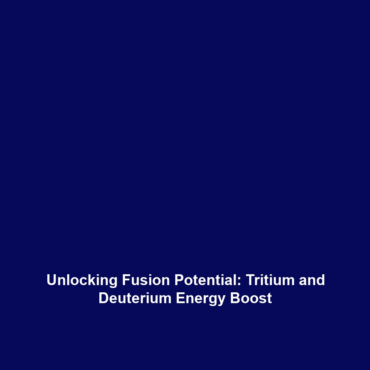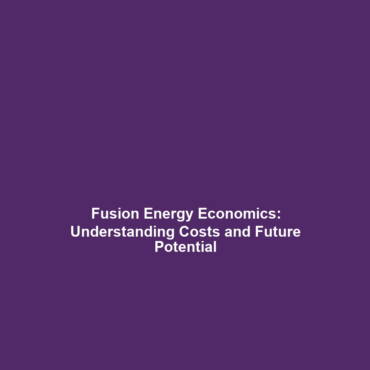Fusion Potential: Harnessing Deuterium and Tritium for Energy Production
Fusion Potential: Used in Conjunction with Tritium, Deuterium Can Fuse to Release Significant Amounts of Energy
Introduction
Fusion energy stands as one of the most promising solutions to the global energy crisis, with the potential to provide a nearly limitless source of clean power. At the heart of this revolutionary technology are the isotopes deuterium and tritium. When fused, these isotopes release enormous amounts of energy, making them vital in the quest for efficient fusion energy. This article delves into the fusion potential of deuterium and tritium, discussing its significance, applications, challenges, and future research within the broader context of Fusion Energy.
Key Concepts
Understanding the fusion potential of deuterium and tritium requires an exploration of several key concepts in fusion energy science.
Fusion Process
During the fusion process, deuterium (D) and tritium (T) atoms collide under extreme temperature and pressure, overcoming electrostatic repulsion to fuse, forming helium and releasing a neutron. This reaction is the most energetically favorable fusion process known today.
Energy Release
The fusion of deuterium and tritium releases about 17.6 MeV (million electron volts) of energy per reaction, a significant amount compared to chemical reactions. This immense energy output forms the basis for potential advances in Fusion Energy.
Applications and Real-World Uses
The applications of deuterium and tritium fusion are numerous and impactful in the field of Fusion Energy.
- Nuclear Fusion Reactors: Proposed reactors like ITER (International Thermonuclear Experimental Reactor) aim to utilize D-T fusion to produce energy.
- Space Exploration: The potential use of fusion propulsion systems could allow spacecraft to travel vast distances in shorter times.
- Medical Applications: Fusion technology could be adapted for use in medical isotopes production.
Current Challenges
Despite the promise of deuterium and tritium fusion, several challenges exist in its research and application:
- Technical Challenges: Achieving and maintaining the necessary conditions for D-T fusion is technologically demanding.
- Material Constraints: Developing materials that can withstand the extreme environments of fusion reactors.
- Cost: The financial investment required for fusion research remains substantial.
Future Research and Innovations
Future research in D-T fusion is crucial for unlocking the true potential of Fusion Energy. Innovators and scientists are focusing on:
- Next-Generation Reactors: Advances in tokamak and inertial confinement designs to enhance efficiency.
- High-Temperature Superconductors: This technology could improve magnetic confinement methods used in fusion reactors.
- Alternative Fuels: Research into other fusion fuel cycles, such as deuterium-deuterium (D-D) and proton-boron fusion.
Conclusion
The fusion potential of deuterium and tritium represents a significant frontier in the realm of Fusion Energy. As researchers and engineers work to overcome existing challenges and innovate new solutions, the prospect of a sustainable, clean energy source becomes increasingly attainable. For those interested in the future of energy, staying informed on these developments is vital. For further reading on related topics, consider exploring applications of fusion energy and current fusion research updates.









